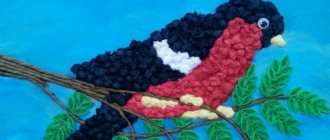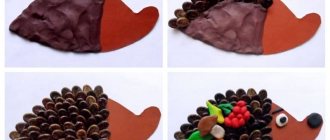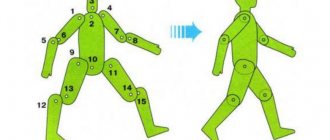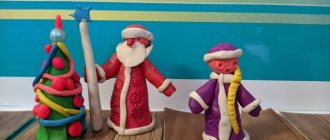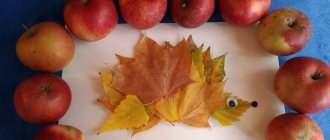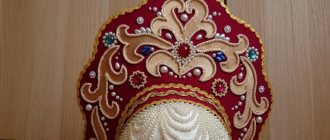Specific options for compositions on the topic “Water transport” in the senior group
Traditionally, in the second half of the school year (February), pupils of the senior group are offered an application on the theme “Steamboat”. A similar activity can be timed to coincide with February 23, and then a postcard with a picture of a steamship will become a gift for dad or grandfather.
In addition to the steamboat, you can offer preschoolers other variations on the theme of water transport. So the topic of the lesson can be designated as “Motor ship”, having previously explained to the children how these two types of transport differ (since the main role here is played not by external differences, but by the principle of operation of the engine).
Children can also use appliqué to create an image of a sailboat, submarine, or yacht (the teachers first explain in detail the characteristic features of each type of water transport).
In the older group, appliqué work on this topic can be done collectively, with each child performing some part of the composition. All elements are then combined against a common background. The topic of such a lesson can be designated as “Boats on the River”, “Seaport” or “Ships in the Roadstead”.
How ship appliques are made
A bright applique of a boat made of colored paper does not require much experience. Often, already in the middle group of kindergarten, children can independently complete a craft, relying on the teacher’s explanations. The senior and preparatory groups of children are capable of small independent improvisations in composing sea compositions.
When preparing lessons in applied arts for younger groups, teachers prepare parts from colored paper in advance. A base with contours is also often used.
Required materials and tools
Before starting work, it is recommended to carefully prepare the workplace for the child. You should pay attention to the lighting and safety of items that will be used in class. To avoid additional cleaning, it is recommended to cover the table with oilcloth or newspaper.
For classes you will need the following materials and tools:
- colored, white paper;
- cardboard;
- simple pencil, ruler, eraser;
- scissors
- glue stick or PVA;
- brush for applying glue;
- felt-tip pens, colored pencils;
- wet wipes for hands.
Class notes
| Author's full name | Title of the abstract |
| Yanova O. | "Steamboat" Educational objectives: learn to compose an image of a steamship from parts, consolidate the ability to cut off the corners of a rectangle, cut out other parts of a steamship of different shapes, practice cutting out identical parts from paper folded like an accordion, improve the ability to harmoniously arrange an image on a sheet. Developmental tasks: enrich preschoolers’ knowledge on the topic “Water transport”, develop imagination, fine motor skills, and attention. Educational tasks: cultivate accuracy, patience, perseverance. Integration of educational areas: “Artistic creativity”, “Cognition”, “Communication”, “Socialization”, “Health”. Demo material: pictures depicting a steamship, a ship's captain. Handout: sheets of blue paper according to the number of children, white and brown paper rectangles, small pictures with the image of the captain, glue, scissors, oilcloths, glue brushes, rags. Progress of the lesson: The lesson begins with a riddle about the postman. The teacher reports that the postman brought two envelopes to the group. The first contains a riddle about the captain:
There are also paper parts for appliqué: white and brown stripes, one long and wide, the other narrower and shorter. The captain wants to teach the children how to make a steamboat out of two rectangles. Physical school is carried out:
The teacher repeats the rules for handling scissors with the children. The teacher explains the sequence of making the steamer. First, you need to cut a trapezoid from a large rectangle by bending it in half and cutting off the corners. Then a pipe consisting of a square and a rectangle is cut out. Round portholes are cut out of a square folded in four. Independent activity of children. Analysis of works. |
| Gurina O.A. | "Ship" The teacher informs the preschoolers that the country will soon celebrate a holiday - Defender of the Fatherland Day. There is a conversation about dads who were once soldiers because they served in the Army. It is discussed what qualities a soldier should have. Physical school is carried out:
The teacher talks with the children about what they can give to dad and leads them to the conclusion that the best gift is the one made with their own hands. The teacher offers to make dads a postcard with a picture of a boat and reads a poem to the children:
Children share their impressions after listening to the poem. The finger game “Brave Captain” is being played:
The teacher explains the stages of making the craft. Moreover, the sun and waves are cut out with curly scissors. The ship has a sail, which is located at an acute angle upwards. The sailboat is accompanied by faithful friends - white gulls. Independent activity of preschoolers. At the end of the lesson, the children dance to the song “Blue Water.” |
| Kazunina Yu.P. | "Submarine at Sea" The lesson begins with a riddle about a submarine:
The teacher shows the children a presentation about this type of water transport. The children learn that all submarines are dark in color and have a distinctive shape. The teacher shows the children a sample of the applique that she made in advance. A sheet of paper is tinted with wax crayons, and the sky is multi-colored. This happens when the sun drops below the horizon. The submarine is glued in the middle of the sheet because it is the main element of the composition. The sun is a yellow circle, and the clouds are designed in a broken way from a white rectangle. Seagulls complement the seascape. Physical education is conducted to the music:
Independent work of children. Exhibition of finished compositions, discussion of the features of the works, highlighting the most spectacular and neat ones. |
| Ushmaeva M. | "The boat is sailing, sailing..." (application with drawing elements) The teacher reads the English song “The boat is sailing, sailing”:
The teacher informs the children that they have arrived on a fabulous uninhabited island and invites them to play the game “The Sea Is Worried Once.” Next, preschoolers are invited to a magnetic board, where reproductions and pictures of ships are presented. The children discuss what they saw. The teacher reads an excerpt from “The Tale of Tsar Saltan...” by A.S. Pushkin:
Children are invited to conduct an experiment - blow on a paper napkin and show how “the wind blows across the sea.” Then the teacher informs the children that they will make an applique of a sailboat today. The structure of a sailing ship is clarified, and methods for depicting volumetric sails are discussed. For preschoolers who can quickly complete the task, the teacher suggests creating relief waves using napkins. Physical education “Seagulls are circling above the waves” is being held:
Independent activity of preschoolers. Summing up the lesson. |
Templates for printing and cutting
The proposed templates can become the basis for creating your own crafts. And in order not to waste time, you can simply print out the boat and make a bright applique.
Assembling geometric shapes with children
Applications on the theme of a boat can become the basis for educational activities for children. To develop design skills and spatial imagination, you can invite children to fold a sailboat from geometric shapes. Examples of finished ship options:
Photo gallery of finished works - ideas for teachers
The application is combined with gouache painting and plasticineography
The applique is combined with drawing with wax crayons. A combination of applique (boats made using origami) and drawing (the sky and reeds)
Original waves are made from strips using the breaking technique
Simple origami, which is complemented by drawing
Application in the form of a postcard for dad with original waves (the teacher prepares them)
A broken applique with filling in a drawn template. Children fill in the drawn outline with pieces of paper; sails made from bright fragments look colorful
Applique classes should practice and improve the visual skills of preschoolers, as well as expand their horizons and knowledge about the shape of surrounding objects. Thus, the theme of a boat or a boat sailing along a river can be played out in a very interesting way, using the right motivation and using unusual materials.
How to make a paper boat with your own hands
Paper crafts are considered the simplest boats. They fold quickly, do not require much time to create, and the child can decorate and color it as desired.
How to make a two-pipe motor ship from A4 paper: step-by-step diagram
You can make a boat from a sheet of paper in different ways and the models come out different. The most classic options are familiar to everyone, and the scheme for folding a paper boat is passed down from parents to children. But for those who have forgotten, there are step-by-step descriptions.
To make a paper boat, we need a sheet of paper and scissors.
Make a square from a rectangular sheet of A4 paper. Fold the sheet diagonally and carefully cut off a strip from the edge.
In the resulting square, fold all 4 corners towards the center. Turn the workpiece over and fold all the corners towards the center again. And let's repeat it again. Let's turn the workpiece over and unfold two small squares - this is how we get the pipes of the future ship.
We put these pipes together and smooth them out.
A4 paper boat: classic paper version
This version of a paper boat is familiar to many. You can make it from a white sheet of paper and then paint it and glue decorative elements. But you can use colored paper to make your boat different from the rest. This option for making a boat is ideal for getting ready for a walk in 10 minutes in rubber boots and launching boats with friends in large puddles.
To make a boat from a sheet of A4 paper, fold the sheet in half.
The upper corners must be bent at right angles to the center.
Fold the free edges of the sheet up on both sides.
Fold the loose corners inward to create a triangle.
The corners of the base need to be brought together to form a square.
Now you need to bend the lower corners on both sides up and again we get a triangle.
The angles at the base of the triangle need to be brought together and we get a square. Move the workpiece to the sides by the upper corners.
Move the corners all the way until you get a boat.
Straighten all the corners of the boat to give it stability.
Paper boat: folding pattern
By showing your imagination, you can create dozens of different ships by design.
A boat with a sail or flags will look original
DIY paper boat: step-by-step instructions
Knowing how to make a classic boat and sailboat, you can try to make a double boat or catamaran. In order to make a catamaran, we need a sheet of paper and scissors.
We need to make a square sheet from A4 sheet. Fold it in half, and then fold each half in half again towards the center.
Rotate the rectangle 90 degrees and repeat the folding procedure.
Let's turn the workpiece and see that it is divided into squares. Fold the opposite sides of the square towards the center.
We take the lower corners of the sheet and move them apart. Fold the 2 inner squares diagonally.
Turn the workpiece and repeat the procedure on the other side.
Fold the layout in half and open it, creating volume.
How to assemble a paper boat: diagrams
Add to your collection a few more options for paper boats that are suitable for beginners and experienced shipbuilders. Unusual DIY ship crafts can decorate any children's room.
Tip: to prevent a paper boat from becoming limp in water for a long time, dip it in melted paraffin and dry it. This way it will be able to repel water and will last longer.
How to make a warship out of paper
Ask any boy what his favorite game is and he will name war games. They can be on the ground with an army of soldiers, or using planes or ships.
You can easily make a warship out of paper. It is enough to choose any version of a paper ship, simply paint it with the appropriate colors, and add military attributes.
Such a ship can be made from green paper, or you can pre-paint a white sheet with camouflage.
Let's draw two lines on a piece of paper - horizontally and vertically.
Bend the bottom part of the leaf in half and turn the product over.
We fold the two edges of the figure inward towards the vertical line; they will play the role of the side of the ship.
Let's open the corners at the bottom of the workpiece, which will be the side of the ship.
Carefully fold the top part and bend it upward immediately.
We bend the corners on the sides.
We open the product along the marked lines, and fold the edges of the top closer to the center.
We turn the workpiece.
Paper warship: diagram
A boat with a paper sail: step-by-step description with diagram
A paper boat with a sail looks much more attractive and more similar to the original. Making a boat with a sail is quite easy.
The simplest option is to make a classic boat and attach a mast with sails to it.
You can immediately make a sailboat out of paper. To do this you will need a sheet of paper of any color.
We make a square from a sheet of A4 paper. Fold it in half diagonally to create a triangle.
Unfold the sheet back and fold it in half in the usual way.
Unfold the sheet and fold it in half again on the other side.
Straighten the sheet and bend the corners of the squares drawn with lines towards the center. Fold the craft in half and unfold.
Fold the free left corner towards the center and you will get an open envelope. Bend this edge to the side. We bend this corner into the ship.
We will get something like a diamond.
Bend the right corner up - we get two sails in the end.
Bend the bottom corner back towards the center and turn the product onto your face.
Such a boat can be decorated or some details can be drawn to complete the picture.
Individualization of tasks
In fine arts classes, it is imperative to use an individual approach. So, for children who are not yet very good at handling scissors, you can offer to make only boats (hulls), and for those who are already good at cutting out parts - boats with a sail.
During the applique class, the teacher should actively encourage the manifestation of children's activity and creativity. Some children cope with any work quickly, so they definitely need to complicate the task even more - offer to supplement the composition with details: for example, cut out the sun and clouds from paper or decorate their boat with details. You can also give paints so that the child can depict rain or fish looking out of the water.
There are many options here. The main thing is to captivate the child so that his interest in creativity only becomes stronger.
Some children quickly and efficiently cope with basic work; they definitely need to be given additional tasks in order to maintain interest in creativity
